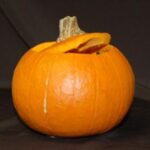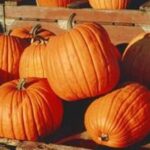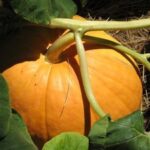Squash was used extensively in North American by American Indians prior to the arrival of Europeans to the continent Squash belongs to the gourd family Cucurbitaceae. This family also contains other important vegetables, such as cucumber, melons and pumpkins. Actually there is much controversy as to what is a squash and that is a pumpkin and often the terminology becomes quite confusing. Garden squash is normally divided into two classifications, summer and fall-winter squashes.
Summer squash is a versatile, fast maturing and highly productive vegetable. For best quality they are harvested when very young and tender. In general summer squash is too old for harvest when the outer skin is not easily pierced by the thumbnail. The fruits should be kept picked to encourage a continuous supply of fruits. Plant summer squash after danger of frost. Plant in hills three to four feet apart using four to six seeds per hill. After plants are up, thin by keeping two or three of the most vigorous plants.
Most summer squashes are of the bush types. Summer squash can be used raw in salads, as for dipping and can be cooked. Care should be taken not to overcook. Zucchini squash is a long, green squash adapted to several gardens. Most zucchini types mature in 50 to 60 days. A newer golden zucchini has become popular and is offered by various seed companies under a variety of names.
Golden or yellow squash are also popular summer squashes in gardens. Generally varieties are available as straight neck or crookneck. Scalloped squash have rather flat, pale green color, turning to white fruits. The fruits have scalloped or fluted edges. A newer variety called scallopini is a dark green with the familiar seal-lopped edges.
Fall-Winter Squash
The fall and winter squashes produce a hard shell which make them ideal for prolonged winter storage. A few can be picked when immature and used like summer squash. The winter squashes can be boiled, baked or made into pies. Most winter squashes are the vining types, although newer bush types are appearing on the market.
Plant winter squash after danger of frost. Plant in hills spaced six to eight feet apart. To store winter squash make sure the fruit is fully mature, but harvest before a heavy frost. Cut the squash from the vine leaving a portion of the stem attached to the fruit. Cure the squash at 80-85 degrees F. or as close to these temperatures as possible for 10 to 12 days. After curing store in a dry 55 to 60 degree area, except for acorn squash. Acorn squash does not require a curing process and should be stored at 45 to 50 degrees.
Butternut squashes are good storage squashes. They have a fine textured flesh that is sweet and has a nutty flavor. Fruits are smooth, light tan in color and are club shaped. The flesh is of a reddish-orange color. They mature in 75 to 80 days. Acorn squash is a good keeper. It is shaped like an acorn, is dark green in color and is deeply ribbed. It has a high quality, orange flesh and a small seed cavity.
Buttercup squash is drum shaped, often dark green with light green stripes. The stem end has a turban-type appearance, but not a pronounced. Newer varieties include orange colored buttercups. Hubbard type squash is considered by many as being the highest quality of the squashes. They range from gold, to blue (grey) to green in color. The hubbard squashes have a long growing season of 90 to 120 days. Some are smooth while others have a warted outer shell. They range from eight to 12 pounds in weight.
Banana squash is another large squash. The fruit has an elongated, cylindrical shape and is a cream color on the outside. Some squashes are sold for their unusual qualities. Vegetable spaghetti is used as a substitute for spaghetti. These oblong fruits can be stored for a long period. The mature fruit can be cooked and when cut open, spaghetti-like strands can be separated from the fruit and used with sauces and seasonings.
Turk’s Turban is often sold as an ornamental squash, although the flesh is edible. This squash has a protrusion from the center and has orangered shoulders and brilliant markings of blotches of red, orange, cream, white and dark green. They are generally eight to 10 inches in diameter. Kuda squash is a new type of squash, with its own distinct flavor. It can be eaten raw when harvested in its immature stages. When it is in its intermediate stage of maturity it has the consistency of eggplant and when full mature can be served by baking and stuffing. It stores like a winter squash.
http://www.thenibble.com/reviews/main/vegetables/squash-glossary.asp





